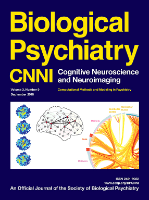
BRAIN TOPOGRAPHY
Scope & Guideline
Pioneering the Study of Brain Activity Through Advanced Imaging
Introduction
Aims and Scopes
- Neuroimaging Techniques:
The journal focuses on studies utilizing neuroimaging modalities such as fMRI, MEG, and EEG to investigate brain activity and connectivity. - Electrophysiological Research:
Research involving EEG and ERP methodologies is a core area, particularly in relation to cognitive processes, emotional regulation, and clinical conditions. - Neuroplasticity and Rehabilitation:
Studies examining neuroplastic changes following interventions (e.g., TMS, tDCS) and their implications for rehabilitation in various neurological conditions are emphasized. - Clinical Applications:
The journal highlights research that applies neuroimaging and electrophysiological findings to clinical populations, including those with neurological and psychiatric disorders. - Cognitive Neuroscience:
BRAIN TOPOGRAPHY publishes research that explores the neural mechanisms underlying cognitive functions such as attention, memory, and emotion. - Methodological Innovations:
The journal encourages submissions that introduce novel analytical methods or tools for neuroimaging or electrophysiological data, enhancing the rigor and reproducibility of findings.
Trending and Emerging
- Microstate Analysis:
The use of EEG microstate analysis has surged, with numerous studies exploring its relationship with cognitive functions, psychiatric disorders, and neurodevelopmental conditions. - Integration of Machine Learning and AI:
There is a growing trend towards employing machine learning techniques for analyzing neuroimaging data, enhancing predictive modeling and classification of clinical conditions. - Neurofeedback and Brain-Computer Interfaces (BCIs):
Research on neurofeedback applications and BCIs is gaining popularity, particularly for therapeutic interventions in mental health and rehabilitation. - Neuroimaging in Aging and Neurodegenerative Diseases:
Studies investigating brain changes related to aging, neurodegenerative diseases, and their impact on cognitive functions are increasingly prominent. - Functional Connectivity Studies:
Research focusing on functional connectivity and its implications for understanding cognitive processes and psychiatric conditions is on the rise, reflecting an interest in network-based approaches. - Cross-Modal Studies:
Emerging research is increasingly integrating multiple modalities (e.g., EEG-fMRI) to provide a more comprehensive view of brain function and structure.
Declining or Waning
- Basic Neuroscience Studies:
Research focusing solely on basic neuroscience without direct clinical or cognitive implications appears to be less frequently published, indicating a shift towards more applied research. - Single-Modal Studies:
There has been a noticeable decline in publications that rely solely on one imaging modality (e.g., EEG only) without integration with other techniques, as the trend moves towards multimodal approaches. - Exploratory Studies without Hypothesis Testing:
Papers that lack clear hypotheses or rigorous testing of specific predictions are becoming less common, possibly due to increasing demands for methodological rigor in research. - Older Techniques:
Research employing outdated methodologies or less advanced imaging techniques has decreased, aligning with the journal's focus on cutting-edge technology and methods.
Similar Journals

Brain Imaging and Behavior
Unlocking Potential: Pioneering Research in Brain ImagingBrain Imaging and Behavior is a premier journal published by SPRINGER, dedicated to advancing the understanding of the relationship between brain function and behavior through innovative imaging techniques. Since its inception in 2007, the journal has provided a crucial platform for researchers and professionals in fields such as Behavioral Neuroscience, Cognitive Neuroscience, and Psychiatry and Mental Health. With an impressive ranking within the Q1 category in Radiology, Nuclear Medicine and Imaging and maintaining strong Q2 status in several other categories, the journal is positioned as a leading resource for groundbreaking research. The journal aims to disseminate high-quality studies that explore neurobiological underpinnings of behavior, utilizing cutting-edge imaging technologies. Although it is not an open-access journal, the visibility and impact of published works in Brain Imaging and Behavior continue to influence the scientific community significantly, underscoring the critical intersection between imaging science and neuroscience.

EXPERIMENTAL BRAIN RESEARCH
Unlocking the Mysteries of the Brain, One Study at a TimeEXPERIMENTAL BRAIN RESEARCH is a renowned journal published by SPRINGER, dedicated to advancing understanding in the field of neuroscience. With a history dating back to 1966, this journal offers valuable insights into the mechanisms of brain function and neurological disorders, making it a vital resource for researchers, professionals, and students alike. While it currently holds a Q3 classification in the field of Neuroscience (miscellaneous) and ranks #73 out of 113 in Scopus's General Neuroscience category, it continually contributes to fostering innovative research and collaborative dialogue. The journal is not open access, ensuring that although content is subscription-based, it maintains a high standard of peer review and scholarly rigor. By covering a breadth of topics relevant to both experimental and theoretical aspects of brain research, EXPERIMENTAL BRAIN RESEARCH serves as an essential platform for disseminating cutting-edge discoveries and theories in the dynamic realm of neuroscience.

Journal of Neuropsychology
Connecting Minds: Where Psychology Meets NeuroscienceThe Journal of Neuropsychology, published by WILEY, is a premier academic journal dedicated to advancing the field of neuropsychology and its related disciplines. With a focus on behavioral and cognitive neuroscience, this journal presents cutting-edge research that informs our understanding of psychological functions and their underlying neural mechanisms. Operating with an impressive impact factor representative of its rigorous peer-review process, the journal has established itself within the Q2 and Q3 quartiles of multiple relevant categories, including Neuropsychology and Physiological Psychology. Researchers will find the ISSN 1748-6645 and E-ISSN 1748-6653 useful for academic referencing as they explore articles that span innovative methodologies and insights into neurological conditions. Published continuously since 2007, the Journal of Neuropsychology stands as a vital resource for professionals and students alike, fostering scholarly discourse and knowledge exchange in neuropsychological research.

Biological Psychiatry-Cognitive Neuroscience and Neuroimaging
Bridging Biological Psychiatry and Cognitive NeuroscienceBiological Psychiatry-Cognitive Neuroscience and Neuroimaging is a leading interdisciplinary journal published by Elsevier, focusing on the convergence of biological psychiatry, cognitive neuroscience, and advanced neuroimaging techniques. With its prestigious Q1 rankings across essential categories such as Biological Psychiatry, Cognitive Neuroscience, and Neurology (clinical), this journal is at the forefront of research that examines the complexities of mental health through innovative methodologies. Covering a broad spectrum of topics from neurobiological mechanisms to clinical applications, it aims to provide a platform for scholars and practitioners to exchange insights on mental disorders and their neurobiological underpinnings. The impact factor and Scopus rankings further underscore its importance, with rankings highlighting its position in the top percentiles of related disciplines. By fostering an open exchange of ideas and promoting cutting-edge research, this journal is an essential resource for researchers, professionals, and students dedicated to advancements in the understanding and treatment of psychiatric and neurological conditions.

PSYCHOPHYSIOLOGY
Connecting Neuroscience with Human Experience.PSYCHOPHYSIOLOGY, published by WILEY, stands as a leading journal in the intersection of psychology and physiology, contributing significantly to our understanding of the brain and body connection since its inception in 1964. With an impressive scope covering areas such as biological psychiatry, cognitive neuroscience, and neuropsychology among others, the journal has earned multiple Q1 rankings in these critical domains as of 2023, reflecting its high impact in the field. The journal ranks particularly well in categories such as Experimental and Cognitive Psychology and neurology, indicating its status as a pivotal resource for professionals and researchers committed to advancing knowledge in psychophysiological studies. Furthermore, with an e-ISSN of 1469-8986, PSYCHOPHYSIOLOGY is accessible to a global audience, although it is not part of the Open Access movement, ensuring that its rigorous research remains a trusted source for academic excellence. By engaging with this journal, readers can expect to discover pioneering research and significant findings that push the boundaries of current understanding, making it an essential publication for those invested in the advancements of psychological and physiological sciences.

Neuropsychologia
Pioneering Research at the Nexus of Psychology and NeuroscienceNeuropsychologia, published by PERGAMON-ELSEVIER SCIENCE LTD, is a premier journal that delves into the intersections of psychology and neuroscience, specifically focusing on behavioral and cognitive processes. Since its inception in 1963, this esteemed journal has been a vital platform for researchers, professionals, and students, showcasing innovative studies and advancements in the fields of Behavioral Neuroscience, Cognitive Neuroscience, and Experimental Psychology. With a commendable impact factor, placing it in the Q2 category across multiple disciplines, Neuropsychologia is recognized for its contribution to the scientific community, ranking among the top journals in both Experimental and Cognitive Psychology and Neuroscience. The journal's commitment to excellence is evident in its rigorous peer-review process and its mission to disseminate cutting-edge research, making it an invaluable resource for those seeking to expand their knowledge and insights in neuropsychology. For further reading, the journal is accessible in both print and digital formats, ensuring that researchers can easily engage with the latest findings and theoretical advancements in this dynamic field.

TRENDS IN NEUROSCIENCES
Navigating the Evolving Landscape of NeuroscienceTRENDS IN NEUROSCIENCES, published by CELL PRESS, is a leading journal in the field of neuroscience, offering cutting-edge insights and important developments in the rapidly evolving landscape of brain research. With an impressive Impact Factor and ranking in the top quartile (Q1) of the category for Neuroscience (miscellaneous), it is positioned as a vital resource for researchers and professionals seeking to stay abreast of the latest discoveries and trends from 1978 to the present. Specifically ranked #3 out of 113 in General Neuroscience by Scopus, this journal promotes the interdisciplinary exchange of ideas and knowledge, making it an essential platform for students and experienced scholars alike. Although it is not an Open Access journal, its value lies in its rigorous peer-review process and commitment to maintaining the highest standards of academic integrity. By continuing to explore the complexities of neural processes and behavior, TRENDS IN NEUROSCIENCES plays a crucial role in shaping the future of neuroscience research and education.

BEHAVIOURAL BRAIN RESEARCH
Illuminating the Interplay Between Mind and BrainBEHAVIOURAL BRAIN RESEARCH, published by Elsevier, is a leading scholarly journal that has been at the forefront of research in Behavioral Neuroscience since its inception in 1980. With an ISSN of 0166-4328 and an e-ISSN of 1872-7549, this journal caters to a global audience of researchers and professionals keen on exploring the intricate relationships between behavior and neural processes. As of 2023, it holds an impressive Q2 ranking within its category, showcasing its significant impact with a Scopus rank of #28 out of 88 in the field, placing it in the 68th percentile. While the journal does not offer open access, it remains accessible through institutional subscriptions, ensuring that its high-quality research is disseminated effectively. The journal's commitment to advancing knowledge in behavioral neuroscience makes it an indispensable resource for those looking to delve deep into the complexities of brain-behavior interactions and foster innovative approaches in both research and clinical applications.

Aging Brain
Fostering Innovation in Gerontology and NeuroscienceAging Brain is a premier Open Access journal published by Elsevier, dedicated to advancing the understanding of the neurobiological changes associated with aging. Since its commencement in 2021, this journal has been pivotal in disseminating high-quality research that explores the intricate relationships between aging and cognitive functions, neurological disorders, and overall brain health. With a notable commitment to open accessibility, Aging Brain ensures that vital findings are available to a global audience, fostering collaboration and innovation in the field. Researchers, healthcare professionals, and students alike will find a rich repository of cutting-edge studies, reviews, and insights aimed at addressing the complexities of the aging brain. The journal stands as an influential platform for those passionate about enhancing the quality of life for the aging population, making it a valuable resource in gerontology and neuroscience.

NEUROREPORT
Connecting minds through groundbreaking neuroscience.NEUROREPORT is a distinguished journal in the field of neuroscience, published by Lippincott Williams & Wilkins. With an ISSN of 0959-4965 and an E-ISSN of 1473-558X, the journal has established itself as a vital platform for disseminating innovative research and developments in the dynamic area of neuroscience since its inception in 1990. Currently, it is positioned in the Q3 category of the 2023 Journal Rankings, reflecting its respectable standing within the community of neuroscience professionals, ranked #74 out of 113 in general neuroscience on Scopus, placing it in the 34th percentile. While it operates on a traditional subscription model, NEUROREPORT is committed to fostering knowledge sharing in the realm of neurobiology, neuropharmacology, and cognitive studies among researchers, professionals, and students alike. With its broad scope and commitment to scientific excellence, the journal continues to be a cornerstone for those seeking to stay ahead in the evolving landscape of neurological research.